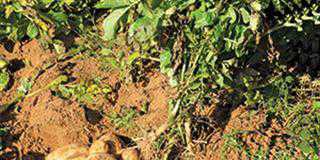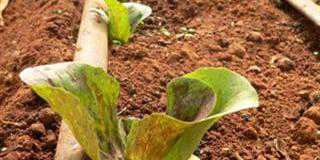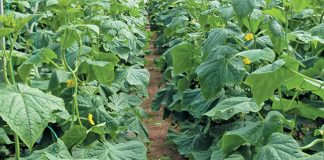
Photo: Denene Erasmus, SAB's hops is grown
The entire hops industry in South Africa is situated in the Southern Cape, a short scenic drive from George. This area, with some of the longest summer days in the country, is the best for growing hops and this is where SAB’s hops is grown.
Only around 400ha is under this specialised crop, with some farms being owned and managed by SAB Hop Farms while private producers have contracts with SAB, based on their area under hops. This contract system regulates the industry, protecting growers from over-production and ensures that SAB’s hops is grown.
Read: Still tilling the soil after six generations
Hops for SA
While the area is climatically suited to hops production, some other conditions are not ideal. Laurie Conway, the general manager of SAB Hop Farms, explains that the optimum latitude for production is 45° north and south of the equator. As George is situated 34° south and experiences mild winters (hops prefers freezing temperatures) with three fewer hours of sunlight than the ideal, the challenge to develop a true South African hop variety is a daunting one.
“SAB requires hops suited to its brands. This means the aroma and bitterness have to be in line with what beer drinkers favour. Producers, on the other hand, want a variety that delivers high, good quality yields and can be cultivated profitably,” he explains. All the varieties grown commercially have been bred in George for warm winters and shorter days in summer, as international varieties are not adapted to the climate and 34° latitude.

Laurie Conway
The research and development team at the company focuses on hop breeding and development, while also managing the quality aspects of the process using scientific equipment to measure moisture, determine the ripeness of hops and the bitter and aromatic value of the plants. Laurie explains that about 80% of all the hops used by SAB for beer brewing are of locally bred varieties developed in George.
“This means that whenever you enjoy one of SAB’s mainstream brands, you can be sure that you have the benefit of a high quality, locally produced product to thank for its unique aroma and bitterness.”
Turn off the lights
In the past, when farmers were growing earlier locally-bred hop varieties, they used large electric lights to extend the effective daylight length for maximum production. Five 1 000W lights mounted 18m above ground level would provide enough light for only 4ha of hops.
“The main variety grown at that time was the Southern Brewer. Its productivity would increase by 30% when supplemented with artificial light,” recalls Laurie. “The challenge was to develop a cultivar better suited to South African conditions – one that could produce high yield, despite our shorter days and milder winters, and could be grown without the use of lights.”
At the time, the
electricity price was not nearly as high as it is today. Nonetheless, the cost of power made it one of the main reasons for developing a variety independent of supplementary lighting to save on production cost. Laurie achieved this goal and since the early 1990s, farmers have been growing mostly Southern Star, Outeniqua and Southern Promise varieties. “These are exceptionally well suited to the climate,” he explains.
“They are unique in requiring fewer hours of daylight. This is especially the case with Southern Star and Outeniqua, which actually produce better when grown without supplementary lighting than with it.”
Hops production
The hop plant is a perennial vine and only female plants are grown commercially. The ‘cone’ used in the beer-making process is the non-pollinated fruit. Male plants are grown separately for pollination purposes.
During a year of good rainfall, 40% to 50% of the total water requirement of the hop plants is in the form of rain and the rest is applied via permanent drip irrigation.

Barley undergoing the malting process at SAB Maltings in Caledon on a malt bed. Other main ingredients in beer are malted barley, maize and water. The malting plant processes 220 000t of barley every year to produce 178 000t of malt.
According to Laurie, the cost of establishing a hectare of hops can be as high as R150 000, much of it for erecting the 5m-high framework on which the hops grow. The plant material and establishment costs approximately R20 000/ha.
Yield depends on growing conditions, but averages 2 000kg/ha annually. This is about 10% lower than the average yield achieved by hops growers in the northern hemisphere. Production costs locally are higher than those overseas, as double the plant population is needed at 34°.
The future
SAB Hop Farms produces an annual yield of nearly 290t on 147ha. This amounts to 36% of the hops grown in South Africa.
The company contracts independent producers to grow the other 64% – an annual yield of about 500t on a total of 255ha. This 790t of hops supplies 70% of SAB’s total needs, but as the crop requires highly specific growing conditions, there is limited scope for growth.
The other 30% is imported from the northern hemisphere. However, Laurie is adamant that this does not mean there is no development potential in hops farming. The industry is fortunate that no diseases affecting hops currently occur in the country. However, farmers monitor for specific pests such as red spider mite and bollworm, and spray for control when populations increase to unacceptable thresholds.
“The fact that the industry is 100% disease-free is a major risk as local hop varieties have limited resistance to diseases,” admits Laurie.
“And we have no spraying programmes in place should an outbreak occur.” To mitigate this risk, the company’s research and development team has embarked on a long-term breeding programme to develop new varieties resistant to diseases such as powdery mildew, downy mildew and Verticillium wilt.
Laurie also points out that currently it is still about 15% more expensive to grow hops locally than import them. This is why the research and development team is working to develop the ultimate competitive hop variety.
Contact Laurie Conway on 044 802 8415 or email [email protected]
This article was originally published in the 12 April 2013 issue of Farmers Weekly.













